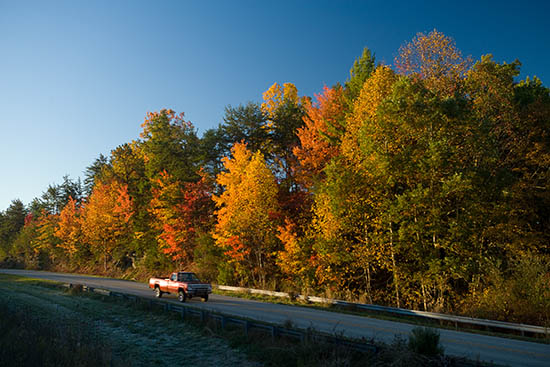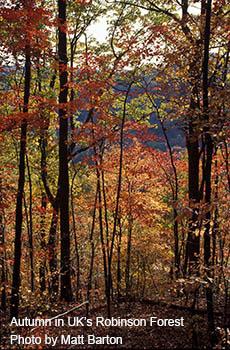As greens fade, reds and yellows pop
As greens fade, reds and yellows pop

Every year around this time, nature puts her greens to bed and awakens her autumn colors. That array of reds, yellows and oranges painting the landscape is part of a very important ecological process.
Throughout the growing season, chlorophyll, the green pigment in leaves, photosynthesizes sunlight and carbon dioxide into sugars trees need to survive and thrive. As daylight hours shorten in late summer and early fall, a layer of cork cells forms at the base of each leaf. This restricts the flow of water and minerals into the leaf, which means spent chlorophyll cannot be replaced. As chlorophyll dies, it no longer masks other pigments present in the leaf —the yellows, oranges and browns of carotenoids.
The quality of light also affects color brilliance. The production of one group of leaf pigments, the anthocyanins, is dependent on the breakdown of sugars in the presence of the bright light in late summer.
In the best of years, autumn foliage in Kentucky would stack up against any rival. University of Kentucky extension forester, Laurie Thomas attributes that to the state’s location.
“Our diverse climate and soil composition mean many tree species common to both northern and southern states grow here. That rich variety means Kentucky enjoys the full palette of fall colors,” said Thomas, who works in the Department of Forestry and Natural Resources in the College of Agriculture, Food and Environment.
 Tree species have their own signature colors at this time of year. Oaks typically show their reds and browns. Shades of yellow show up in hickories, Kentucky coffeetrees, and the state tree, the tulip poplar. Maples have a stunning array of colors, depending on the variety. Sugar maples turn orange-yellow or orange-red and red maple takes on a deep red hue. The native sassafras tree shows a rainbow of deep orange, yellow, scarlet and purple on its mitten-shaped leaves. Some trees, though, disappoint at this time of year. The leaves of elms and pin oaks just turn brown and drop.
Tree species have their own signature colors at this time of year. Oaks typically show their reds and browns. Shades of yellow show up in hickories, Kentucky coffeetrees, and the state tree, the tulip poplar. Maples have a stunning array of colors, depending on the variety. Sugar maples turn orange-yellow or orange-red and red maple takes on a deep red hue. The native sassafras tree shows a rainbow of deep orange, yellow, scarlet and purple on its mitten-shaped leaves. Some trees, though, disappoint at this time of year. The leaves of elms and pin oaks just turn brown and drop.
But even if some trees don’t impress with their color palette, they still contribute to the environment. Nothing is ever wasted in nature, so minerals taken into the leaves during the growing season are recycled after the leaves drop to the ground. When the leaves decompose, their nutrients again are available to be taken up by the area’s flora, and organic materials nourish the soil.
“Year in and year out, the cycle continues, whether the season brings brilliant leaves or faded browns,” Thomas said. “It’s nature’s way of making sure the circle of life continues. This year’s growth feeds next year’s plants and animals.”
It’s early yet. On the calendar, autumn has just begun. A few trees are starting to change, but the big display is still ahead. The Kentucky Department of Tourism reports most areas of the state only show a light stippling of reds and yellows at present. The best color in the state typically peaks around the second and third weeks of October.
The Kentucky Department of Tourism provides weekly updates on fall color at https://www.kentuckytourism.com/seasons/. Nationwide fall foliage predictions can be found at https://smokymountains.com/fall-foliage-map/.
Environment Extension Forestry


